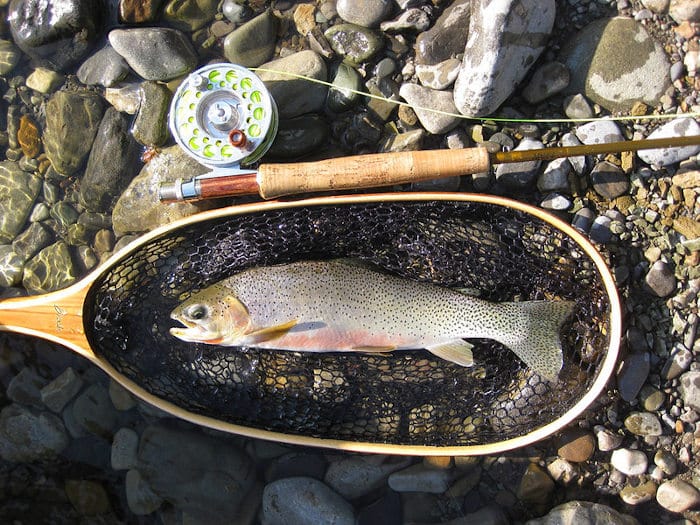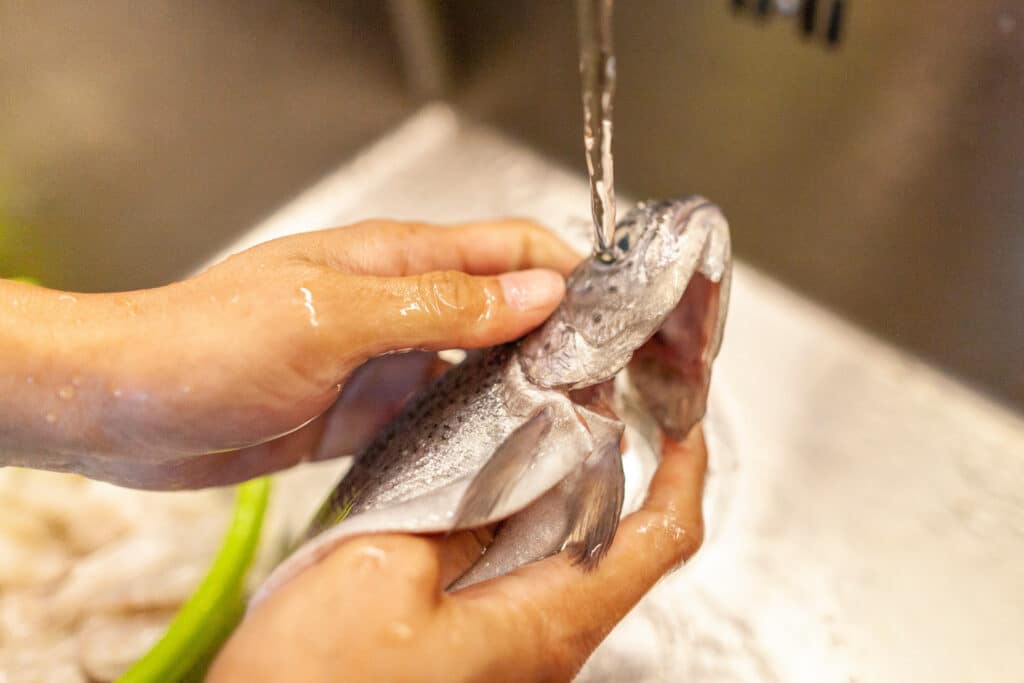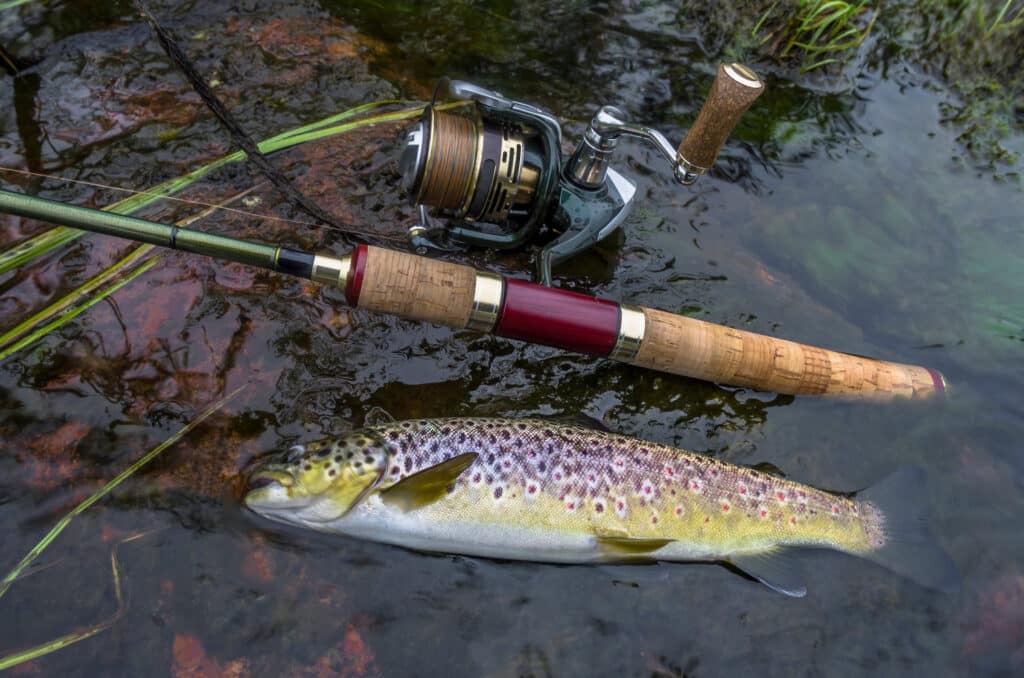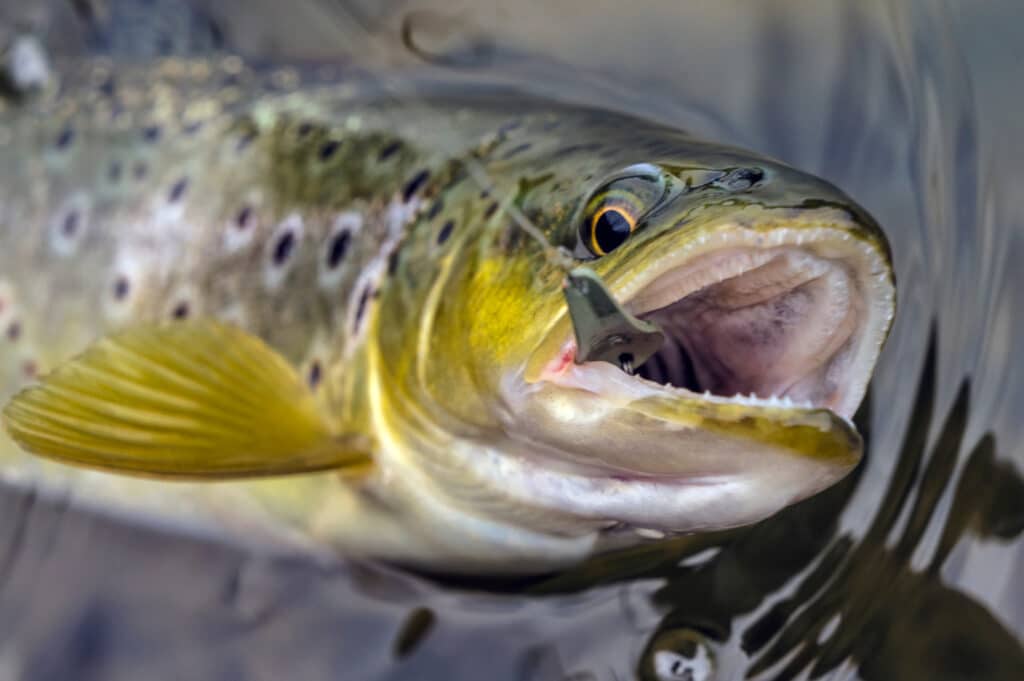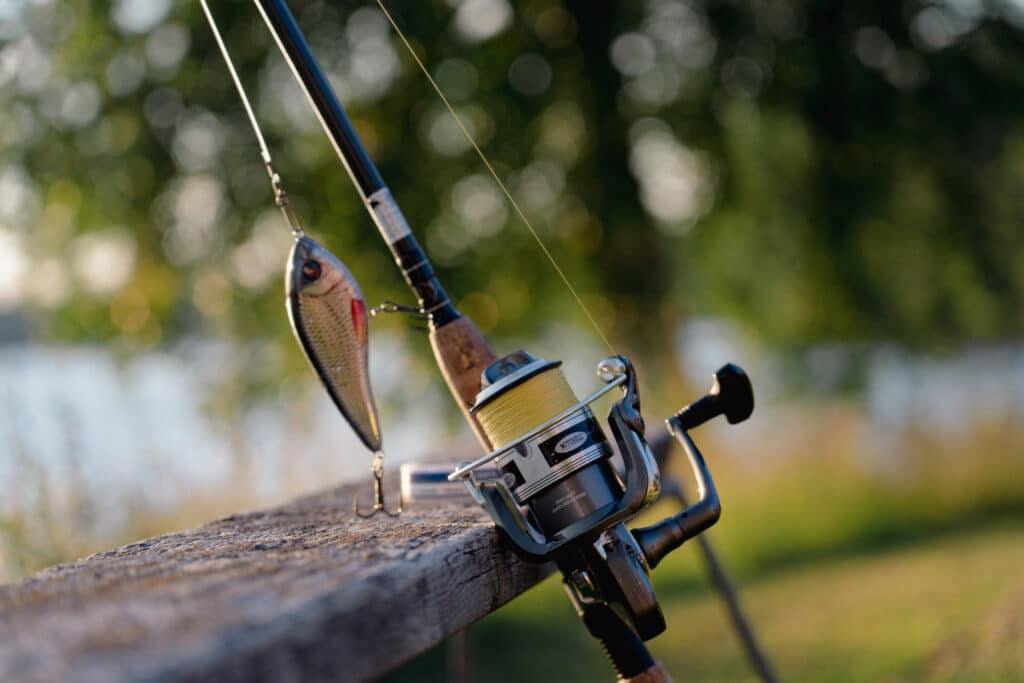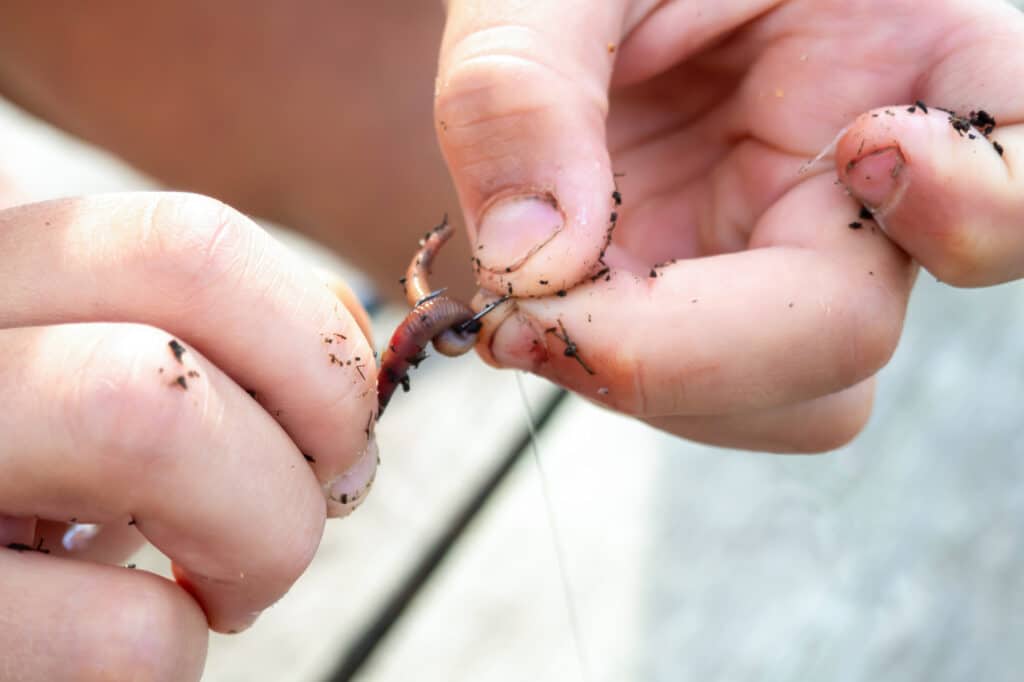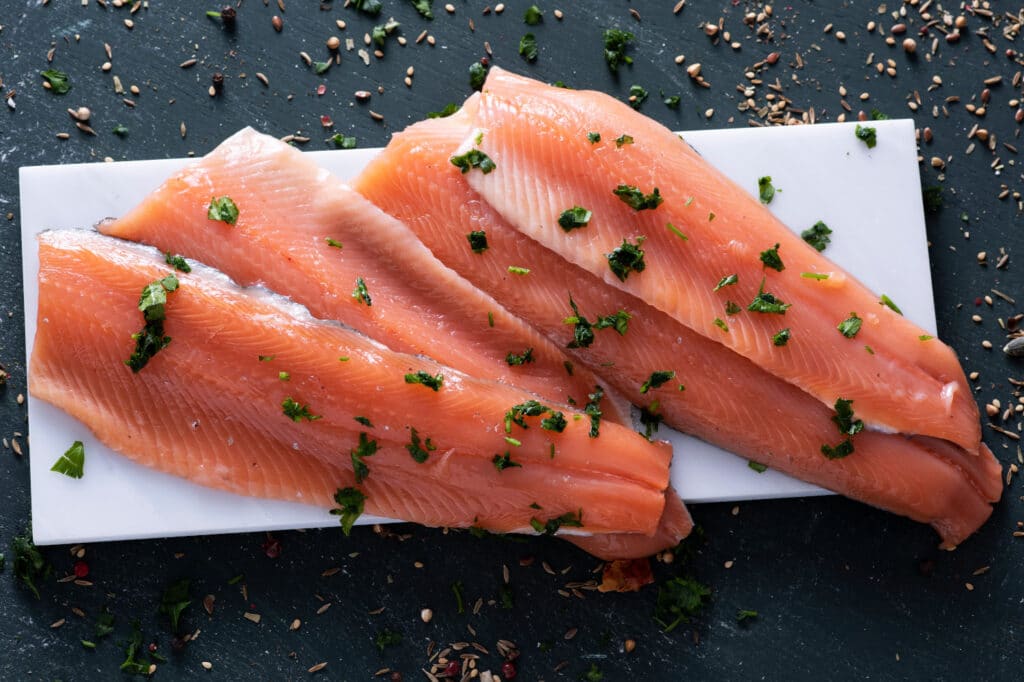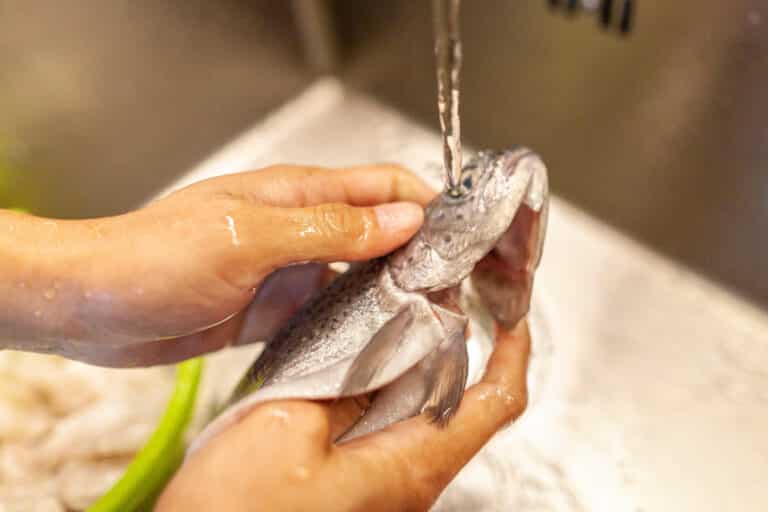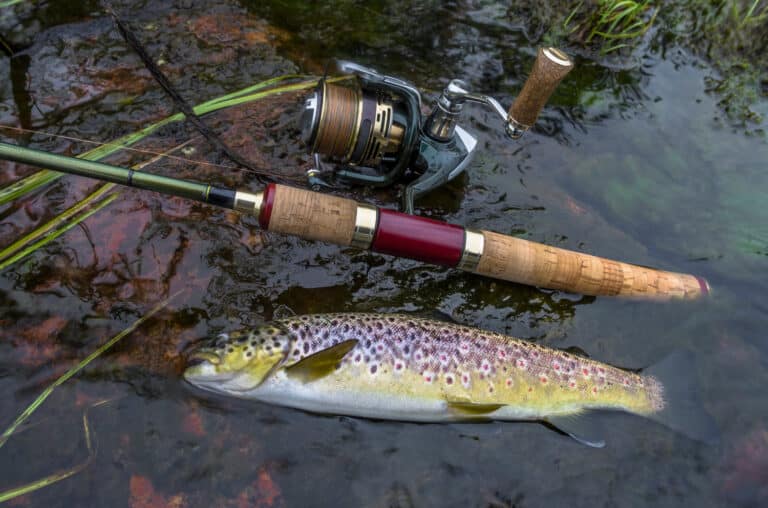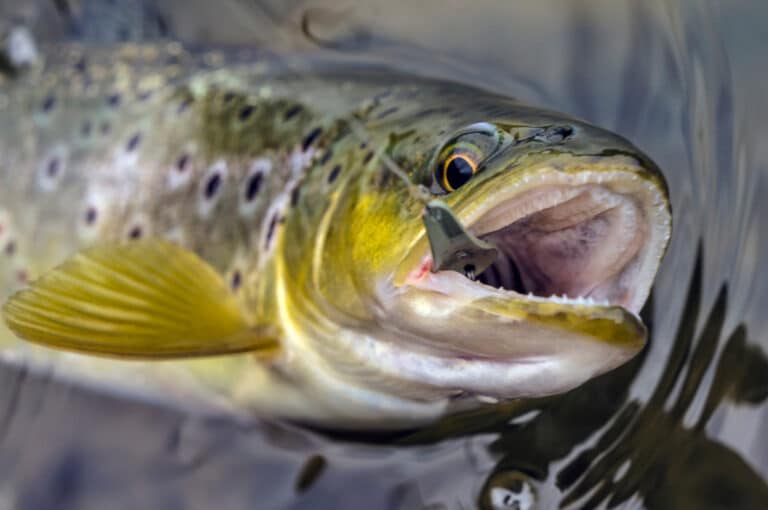Surf perch fishing is, without a doubt, one of the most underutilized fisheries in the United States.
Why? Because they can be fished year-round on just about any ocean beach or coastline, all the way from southern California to British Columbia. Not only that, but they’re abundant, aggressive, and very accessible. And the kicker? Almost no one fishes for them.
That makes surf perch fishing an amazing opportunity for anyone close to the west coast, and a great entry point for surf fishing newbies. In this guide, I’m going to give you all the tools you need to be successful. I’ll cover the gear you need, surf perch rigs, where to fish, and strategies to help you catch your limit.
If you already have your gear, or you just want to find something specific, use the table of contents below to get the information you need.
The Wild Provides is a participant in the Amazon Affiliate program. If you click through one of the links on this site and make a purchase, we may receive a small commission at no extra cost to you. It helps to keep us up and running, but all recommendations are my own honest opinions.
What Are Surf Perch?
Surf perch (or surfperch) are thin, saucer-shaped schooling surf fish, found in coastal waters close to shore. Of all the surf species, perch are generally the most abundant and easy to catch. They can be any one of 22 species in the family Embiotocidae, but the most sought-out species is the redtail surfperch (found from northern California to B.C.). In southern California, barred surfperch, silver surfperch, and walleye surfperch are all common.
Quick Surf Perch Facts
- Record catches exceed 4 pounds but are commonly caught in the 2-pound range
- The record length is 18 inches, but fish around 12 inches are common
- Females give birth to live young in the spring
- They spend most of their lives in the surf zone (20-50 feet offshore) but can be found much deeper.
Because there are so many species and they’re so abundant, surfperch are a great option for first-time surf anglers. They also have high daily catch limits, varying from 12-20 across the west coast (check your local fishing regulations before heading out), and make great table fare.
Fish ID: Redtail Surfperch
Because redtails are commonly sought and some states have specific regulations around them, it’s important to be able to identify your catch. Luckily, they’re pretty easy: just look for the red tail.

Some other characteristics of redtails include:
- 8-12 red or brown bars on the side of the body (often faint)
- Red to pink fins
- Dorsal spines that are taller than the soft rays
The other surf perch species are a little harder to ID and a little less desirable (redtails are the true eater grade perch). But if you do find a big barred surf perch or even a bucketful of silvers, they’ll make solid meals too.
Surfperch Fishing Gear
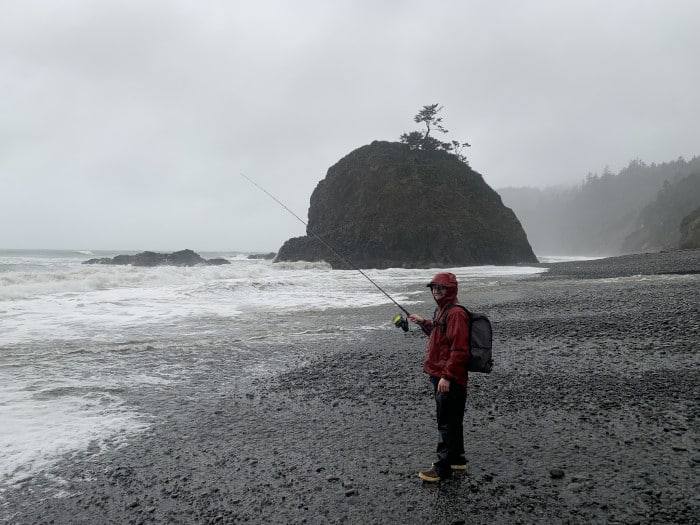
Surf fishing requires a different set of gear than lake or pond fishing. Opinions vary on the best setup, but some specific equipment is essential to catch surfperch successfully.
Surf Rod
There is a lot of room for variation in rod selection. The one thing that all surf fishing rods share, though, is length. Here are the qualities to look for in a surf rod:
- Spinning Rod
- Length: 8″-11″ (depending on your height and experience)
- Action: Medium-fast
- Material: Graphite, for sensitivity and casting power
- Weight capacity: 1-4 ounces (more if you prefer a heavy tackle approach)
Aside from length, these aren’t hard and fast rules. Some anglers feel they can get away with weights as small as 1/2 oz, so they choose a lighter rod to enjoy the fight more. Depending on where you’re fishing, local shops may offer rod rentals so you can see what works best for you.
Another thing to note is that if you have a good chinook salmon rod, it’ll probably work for surf fishing, too. I use my 9′ Heavy Okuma Guide Select Pro for surf fishing and I love it, but the Okuma Rockaway is a surfperch fishing rod that’s relatively affordable, too (about 100 bucks on Amazon).
Reel
Reel selection can also vary, but here are a couple of things to look for.
Size 3000-5000 Spinning Reel: Most surfperch fishermen use a spinning reel because you can cast farther and don’t need the precision of a bait caster. Reel size depends on your line weight. Because you’ll need to make long casts, though, 4000 is the minimum. You can size up if you want to use heavier line, but 4000 series reels are ideal for the rig I recommend (more on this below).
Saltwater specific: This isn’t necessary, but you’ll get more life out of your reel if you buy one made specifically for saltwater, due to the corrosion-resistant materials used. Always rinse your reel off with fresh water after fishing, especially if it’s not designed for saltwater.
My favorite reel for the price is the Okuma Rockaway 6000 (the smallest size they make it in), but if you’re looking for a premium option that’ll last forever, the Penn Battle III 4000 would be my number one pick.
Line
Some people prefer to use monofilament for their mainline and leader, but I recommend a combo that usually works a lot better.
Mainline
For your mainline, your best bet will be braided line in the 15-20 pound range. Braid doesn’t stretch like monofilament line, so it provides greater sensitivity. Mono can stretch a lot, which at the long distances you’ll be casting can cause lots of missed bites.
The second is that because of the smaller line diameter, it has a greater casting distance and less drag. This is especially important in surf fishing, where the wind and surf can drag your line all over the place. Braid is a huge improvement over mono in this regard, and you’ll notice the difference immediately if you’re just switching over.
High-vis braid also gives you a little extra edge that can help you see your line better in the surf.
Leader
Though surfperch aren’t line-shy, you want your leader to be minimally visible. This is why I recommend fluorocarbon leaders in the 10-15 pound test range.
Fluorocarbon stretches less than mono and it provides better abrasion resistance. It’s also nearly invisible, which is better for a stealthy presentation.
Using the rig that I recommend, your leader should be about 3-5 feet in length. Check out this article for the lowdown on the best fluorocarbon fishing lines.
Hook Size For Surfperch
Getting the right-sized hook is critical to catching surfperch. Surfperch have small mouths, so you need much smaller hooks than you might for other saltwater species like sea bass or lingcod.
The best hooks for surfperch are #2 or #4 octopus hooks. #4 may mean smaller fish but more of them, and #2 may mean less fish, but bigger size. This is anecdotal, though, and hook size preference varies from angler to angler. I generally use #4, because I think it’s easier for the fish to take and get a good hookset.
Octopus hooks pretty much set themselves in the surf, so you’ll just need to feel the bite and apply pressure when you do. Because you’re dealing with so much line, you’ll lose a lot of fish if you have to set the hook yourself.
Surf Fishing Weights
The best sinkers for surfperch fishing apply to most types of surf fishing. The goal is to hold your rig in place on the bottom without it rolling around too much.
Usually, three-sided pyramid sinkers work best. They tend to resist rolling and are less likely to get pushed or flipped up by the ebb and flow of the waves. The size you’ll need can vary greatly, ranging anywhere from 1/2 oz to 4 oz. It all depends on the surf conditions and your tackle setup.
There is a ton of debate among anglers surrounding the best sinker weight for surf fishing. What this means for you is that you should probably have a few of each and experiment as you go. If you can’t keep your line tight, or you find it being pulled sideways by offshore currents, you need more weight.
As a rule of thumb, I start with one and a half to two ounces in calm water (less than three-foot swells). As the water gets rougher, I up the weight as necessary, up to about 3-4 ounces. I’ve found that if you need more than that to keep your weight in place, it’s probably not a good day for surf perch fishing (though I’m sure others would beg to differ).
Chest Waders
Chest waders are essential for surfperch fishing. Many great surfperch beaches have a very gentle slope, so if you can’t wade into the water you’ll be too far away from where the fish are.
Being closer to the fish not only means you don’t have to cast as far, but it also means better line control. You’ll be able to keep your line high enough to clear waves, and the closer distance means you’ll be better able to feel the fish bite.
Chest waders do present a huge danger when fishing in the surf, so always keep an eye on the waves. Don’t push your luck by getting out as deep as you can, either. You’ll usually only need to wade in just to the point where if you were wearing hip waders, you’d be getting wet.
Other Gear
Aside from the essentials, there are a couple of other pieces of equipment items you’ll probably want.
- Backpack
- Surf fishing cart
- Polarized glasses
- Cooler
- Fish net (for keeping fish)
You don’t need to bring any of these things, but they can all be nice to have. If you’re keeping fish, you’ll at least need somewhere to put them (I have a cooler backpack that I love for this).
What Is The Best Surf Perch Bait?
Surfperch are opportunistic eaters, snagging just about anything that gets washed their way. On the sandy beaches where they live, food is plentiful. Surfperch will eat:
- sand crabs (also called mole crabs or sand fleas)
- sand shrimp (also called ghost shrimp),
- mussels and clams (specifically clam necks)
- marine worms (commonly called sandworms).
Any of these will also work for fresh bait. Here’s a little more on each of them, including the baits that I think are best.
Sand Crabs: These are extremely popular. They’re abundant across the entire west coast and you can easily catch them yourself. All you need is a sand rake or sand net, and just by sifting through a couple of nets full of wet sand, you can get handfuls of them.
Sand shrimp: These can also be caught yourself, but it’s a little more involved. You’ll need to make or buy a shrimp pump, which pulls sand from deeper down to get to where they live. In my experience, they stay on the hook better than sand crabs and their smaller size makes them a little more attractive to small-mouthed surf fish.
Mussels and clams: These are also easy to gather yourself and make great bait. Their big advantage is that they stay on the hook much better than sand crabs or shrimp, and catch fish just about as well. How easy they are to get varies by location, but along the Oregon coast (where I fish) they’re usually plentiful at low tide. Check your local fishing laws before harvesting.
The Best Surfperch Bait: Berkley Gulp! Sandworms
The last and best bait is sand worms. These are hard to find due to their small size, but there’s an even better artificial alternative: Berkley Gulp Sandworms.
These come in different sizes and colors, can be found at tackle shops across the coast, and are extremely effective bait. They stay on the hook better than natural baits, last longer, and the fish love them just the same. Though you have to buy them, they’re my go-to bait because I hate having to constantly rebait my hooks (which happens constantly with natural baits in the pummeling surf).
You can get Gulp sandworms in just about any tackle shop on the coast, but if you want to order some for your next outing, you can get them on Amazon.
Every angler has their preferences, but here are my rankings of the best surf perch bait, in order from favorite to least favorite.
- Berkley Gulp Sandworms (2 inches, in Camo or Bloody color)
- Clam necks
- Sand Shrimp
- Sand Crabs
Though I have my favorites, I encourage you to experiment with different types of bait and see what works best for you.
How To Tie A Surf Perch Rig
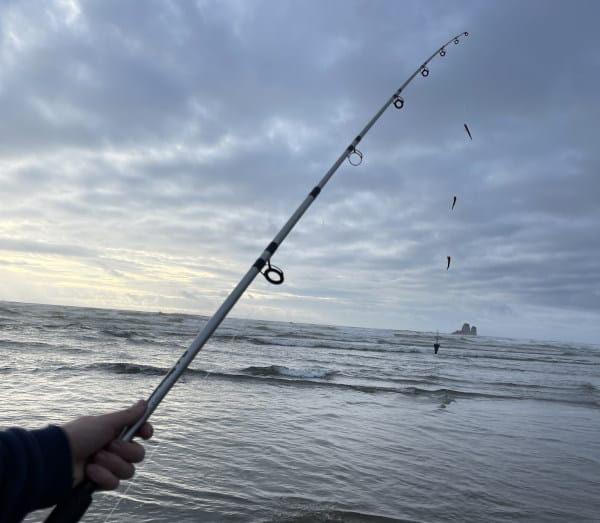
To catch surf fish, you need a rig that will keep your bait exactly where you want it in the surf. You also need that bait to be just a little off the bottom, ideally floating as free as possible to entice these fish into an easy meal.
Surf anglers use several rigs, but there are two in particular that I know work great. They are the hi-low rig and the fish finder rig.
The Hi-Low Rig
When it comes to rigging for surfperch fishing, I think the hi-low rig is your best bet. This is because it lets you use multiple hooks (three if you’re in Oregon). This triples your chances of catching a fish with each cast. And because surf perch are a schooling fish, having as many baits in their zone as possible is a great idea. Catching two, and even three, fish on one cast is not uncommon with this rig.
Here’s what you need to tie it:
- 3-5 feet of 10-15 pound test fluorocarbon line
- 1-4 oz pyramid sinker
- 2-3 circle hooks or octopus hooks
- 2-3 three-way swivels (optional; I prefer to tie dropper loops instead)
- Snap swivel (optional but recommended)
You’ll want your first hook to be roughly 10″-12″ from the sinker, with each hook being 6″-8″ apart. Whichever method you go with, give yourself enough line to accomplish this (I use 3-4 feet when tying dropper loops).
If you’re using 3-way swivels, tying it up is super easy. First, cut lengths of line that will create the right-sized gaps. Then:
- Tie 2 or 3 three-way swivels inline with each other.
- Tie a 3- 4 inch length of line to the third side of each swivel.
- Tie your hooks to those lengths (using a snell or improved clinch knot).
- Tie a snap swivel to the bottom end.
- Attach your sinker.
Tying a snap swivel isn’t necessary, but it allows you to change weights out easily, which is often necessary to adjust for surf conditions. Depending on your line test, it’s also possible to bend a snap swivel out of place when you get snagged. This lets you drop your weight without having to break off your whole rig (and you can trust me, because I’ve done it).
Alternatively, you can tie this rig using dropper loops. These are easier to tie on the fly and don’t cost you money, which is why I prefer them. They also allow you to easily attach hooks without knots (explained below), and the hook will naturally sit facing upright, which amounts to better hook sets.
How To Tie A Dropper Loop
For the best visualization, check out the video above. But here’s a quick explanation of how to tie them.
- Make a large loop (2-3 inch diameter) by folding the line over itself
- Wrap the tag end around the loop (as if you were tying a regular overhand knot) 3 times.
- Use your finger to create and hold a small gap between the loop and the tag end
- Make three more wraps, continuing to move in the same direction around the original loop
- Pull the large loop (the first one you created) through the small loop you created with your wraps
- Hold this new loop tight (I usually do this with my teeth) while evenly cinching down the knot from both sides
Then you can just feed the dropper loop through the eye of your hook, and feed the hook back through the end of the loop. Pull this tight and your hook is attached with no knot tying (and corresponding loss of line) involved.
The dropper loop takes some practice to get just right and know how much line you’ll have left over. But once you learn it, it’s invaluable for all kinds of fishing, and it’s the only way I tie my hi-low rigs.
The Fish Finder Rig
The fish finder rig is also an extremely popular surf fishing rig for good reason. For those of you who fish inshore too, it’s essentially a Carolina rig. While it only has one hook, the use of a sliding sinker means fish won’t feel as much tension from the line when they take the bait. It also allows your bait to float around freely at the end of your line, which is key to imitating the food that surf fish normally eat.
The fish finder rig is extremely simple. Here’s what you need:
- Sinker slide w/ sinker snap (get a “braid friendly” sinker slide, or tie a 2-foot length of fluoro directly to your mainline to prevent abrasion)
- barrel swivel
- 6-12 inches of 10-15 pound test fluorocarbon line
- #2 or #4 circle or octopus hook
This rig is easy to tie. Simply slide your sinker slide onto the mainline (or fluoro leader), tie a barrel swivel to that using an improved clinch knot, then tie your 6-12 inch fluoro leader to the barrel swivel. Tie on your hook at the end, and snap your desired sinker in place. Then this rig is ready to fish!
How To Fish For Surf Perch
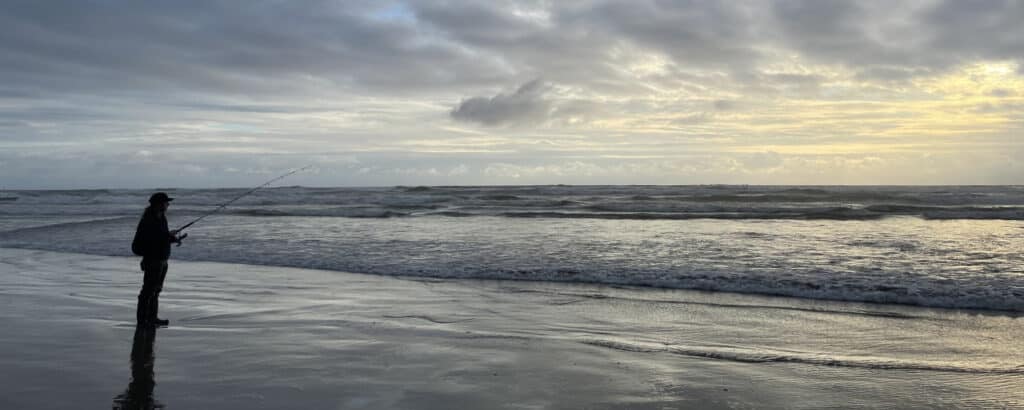
Surfperch fishing involves two things; finding them, and fishing for them. Here’s how to do both.
Where To Fish For Surfperch
Surfperch can be found on coastlines up and down the west coast, just about anywhere you can access them. But like most species, they like to hang around cover. Though you can find them on sandy flats, they tend to congregate around depressions in the bottom or rock formations.
You can find these cover locations by scouting your fishing beaches at low tide. Look along the shore for depressions in the sand (which often hold water at low tide) or rock formations with corresponding holes. These will be the best places to catch fish.
In addition to this, steeper beaches with a near shore break tend to be better than flatter ones. On the Oregon coast, these can be tough to find, but even a little increase in slope is better than none. You can also look for riptides, which the fish congregate around because they stir up food. These can often be found around the mouths of rivers, though even places where small creeks flow into the ocean can be great.
A final tip on location is to fish for them where you find sand crabs. Sand crabs (or mole crabs) are found everywhere, but there are places where they’re especially abundant. You’ll see them floating in the water with every outgoing wave and see skeletons all over the sand. Those are great spots to try fishing.
If you’re not catching surf perch, the best option is to move. Surf perch are usually found in schools, so where there’s one there are more. If you fish for 10 minutes or more without a bite, move a little way up the beach and try again.
Best Time To Fish For Surfperch
Opinions vary on the best time to fish for surf perch, but it’s generally accepted by surf anglers that fishing the incoming tide through high tide is best. It’s not understood why, but anecdotally this is the most productive time. Start 2-3 hours before high tide, and fish until the fish stop biting.
It will also help if you can fish for them during their spawn. According to Oregon Fish and Wildlife, this means spring through early summer. They move closer to the shore during this time and congregate in large schools. During the spawn, the fishing action can be absolutely red-hot (as in bites on every cast and double or triple catches), though you can productively catch them any time of year.
Surf Perch Fishing Technique
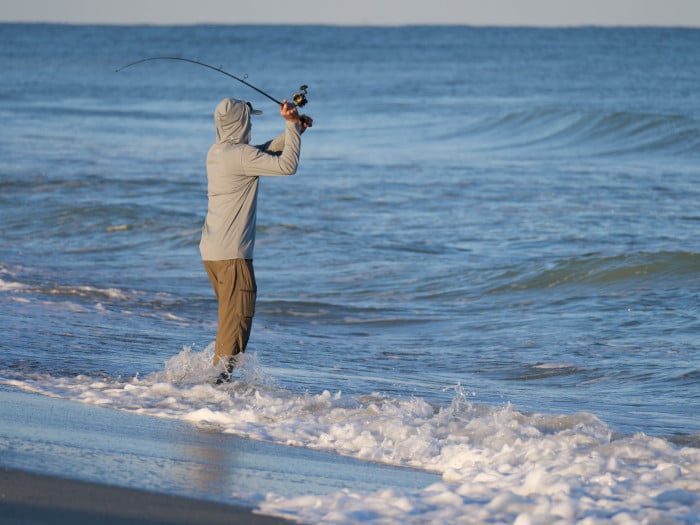
Surf perch fishing is pretty simple. With just a few basic tactics you can catch lots of perch in a pretty short time.
Cast out about as far from shore as you can (fish are usually found in the calmer spots between the first and second breaker or second and third breaker). Then reel up your slack so your line is taught and wait 20 or 30 seconds. Retrieve some more line, then repeat the process. Emphasize a very slow retrieve, because as the waves ebb and flow, fish will move with them. Eventually, your bait will be in front of the fish.
Give it a few casts in one spot before moving. If you don’t get any bites in those few casts, move up or down the beach 20 or 30 yards. Perch are aggressive feeders and they’re always actively hunting, so if you’re not getting bites, it’s because your bait isn’t in front of them.
I’ve noticed through experience that bites tend to come easier when the water is a little calmer in between sets of crashing waves. They can and will come at any time, but if you have your bait in their zone when the water is relatively calm, they’re more likely to bite. I’ll leave my bait in a spot longer than the usual 20-30 seconds if that area is being pounded by waves, because fish often bite right after the set rolls through and the water starts to wash back out.
Once you find where the fish are holding, you’ll only need to cast out to just beyond them to keep getting bites.
It’s pretty much as simple as that! Just keep moving and keep your bait in the water, and you’ll probably catch something.
FAQ
Absolutely. They have a very mild flavor and very soft texture. Some describe it as “mushy,” but you’ll have to try them for yourself to see if you prefer it. They are great steamed or grilled whole, and for those who don’t like the texture, make great fish cakes.
The world record was 18 inches long and 4.5 pounds. Fish close to this size are rare, but 2-pound, 12-inch fish are not uncommon.
You can, though it isn’t the most productive way to catch them. If you want to try, small topwater and diving jerk baits in saltwater colors can work. These can also catch other species of fish, so you may want to adjust your setup to accommodate.
Conclusion
Finally, always check your license requirements and local fishing regulations before fishing. Catch limits vary by state, and some places have length restrictions on redtails. Other than that, keep your lines wet and enjoy the beach!

